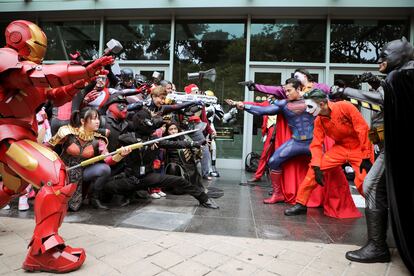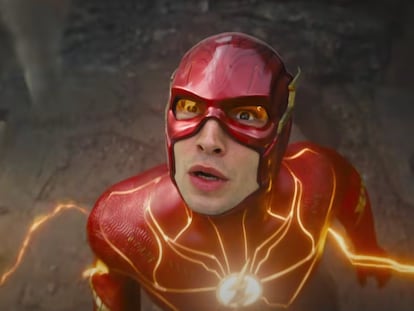#ComicsBrokeMe: Cartoonists come together to denounce poor pay and mistreatment
Dozens of artists, including big names like Neil Gaiman and Kurt Busiek, have spoken out about the difficult working conditions and health problems they have suffered in the industry

In their cartoons, there is always some way to save the day. The hero always arrives at the last minute to foil the villain’s plan. But for the cartoonists themselves, this doesn’t happen, and they have grown tired of waiting for someone to come to their rescue. So dozens of writers and cartoonists, including big names like Neil Gaiman and Kurt Busiek, have begun to publicly denounce the poor pay and treatment they receive from publishers such as Marvel or DC. They are fed up and want to change things. This has led to an outpouring of messages with the hashtag #ComicsBrokeMe — both literally and figuratively.
The fuse appears to have been lit by the recent death of cartoonist Ian McGinty, 38, whose cause of death has not been disclosed. Some suggested that the pressure of work may have contributed to pushing him over the edge, or certainly did not help. His death has opened up Pandora’s box, with cartoonists complaining of infinitesimal payments, abusive contracts, depression, homelessness, long hospital stays and endless legal battles.
David Lasky, for example, recounted that, for the three and a half years that he and Frank M. Young were working on The Carter Family: Don’t Forget This Song, they got an advance of $19,000, which was split between the two. They won an Eisner, the equivalent of an Oscar in the comic book world. But they never got around to publishing a sequel. Why? “After finishing our book, my co-author and I were broke. I went back to work for a bakery. My co-author was homeless for a while,” he wrote on Twitter.
Readers today enjoy more books than ever before, and there is more and more variety. For the author, however, this means reduced circulation. The constant release of new works mean that their books are quickly taken off the shelves to be replaced by newer ones. A few books — and comics — are very successful. But the vast majority fail to make any money. And creators usually get around 10% of these few sales, compared to 60% that ends up staying in distribution. “When I started in comics in 1987, DC Comics was paying me $40 a page for a 24-page comic book. That’s worth somewhere between $120 and $160 now,” Neil Gaiman, the creator of The Sandman and one of the most respected authors in the industry, shared on Twitter. “How anyone survives on current page rates leaves me chilled.”

Most artists will say they are struggling to survive on current page rates. What’s more, the fact that they are mostly freelancers means it is more difficult for them to receive social security benefits and to unionize. The #ComicsBrokeMe hashtag has become a way for cartoonists to share these grievances.
Colorist Chris Sotomayor, who has worked on Captain America and The X Patrol, said that he was so overworked he wound up in hospital for three weeks. “When I got out, my editor fired me, even though I got my work in before I was hospitalized,” he shared on Twitter.
The comic book series Lumberjanes, which won two Eisner awards, also came under fire. Illustrator Anne Marie Rogers said that even working every waking hour, it was not enough for her to meet deadlines, or continue with the project. And colorist Maarta Laiho said she was paid $25 per page and, on a separate project, asked to color 200 pages in two months. She said that the task left her with pain in her arm, but no royalties.

There’s another issue that many artists are no longer willing to accept. While Marvel and DC heroes dominate the cinema, making millions at the box office, cartoonists receive little compensation. Writer Devin Grayson and cartoonist J.G. Jones believed their contract guaranteed them about $25,000 each for the appearance of their cartoon character Yelena Belova in the movie Black Widow. But they received just a fifth of that amount. Their battle, reported by The Hollywood Reporter, did however shine a light on a confusing system, where almost always the artist loses out. They make hardly anything if their hero or story is a smash hit in cinemas around the world. They are often even legally obliged to stay silent. In the industry, this payment is seen as a thank you rather than a duty, several sources told the magazine.
Indeed the business model has been criticized since its very beginning: Jerry Siegel and Joe Shuster sold the character of Superman for just $130; Bill Finger and Jack Kirby — and their heirs — fought for years to be recognized as co-creators, respectively, of Batman and icons such as The Fantastic Four. Just a few days ago, Neal Kirby, Jack’s son, regretted in a statement that the documentary Stan Lee, recently released on Disney +, underestimated his father’s importance in the comic world. And still, to this day, it is difficult to identify the artist behind the cartoon character in either blockbuster movies or amusement parks. Although there are exceptions, such as the film Spider-Man: Across the Spider-Verse.
My father Neal Kirby (Jack Kirby’s son) has asked me to post this written statement in response to the Stan Lee documentary released yesterday on Disney+. pic.twitter.com/V4be2xyEJg
— Jillian Kirby (Granddaughter of Jack Kirby) (@Kirby4Heroes) June 17, 2023
In general, “creators working at Marvel and DC sign work-for-hire contracts granting the publishers ownership over their characters and storylines,” The Hollywood Reporter reported in another article about a compensation cases. It pointed out that, while it seems easy to identify and compensate the creators of a character that appears in a film, the matter is even more complicated with plots. On the set of The Dark Knight, by Christopher Nolan, actor Cristian Bale turned to the comic Batman: The Long Halloween again and again for inspiration. Should its authors, Jeph Loeb and Tim Sale, have received anything? The question remains in the air. Like many others. The future is a blank page. The artists only ask that this time the story has a different ending.
Sign up for our weekly newsletter to get more English-language news coverage from EL PAÍS USA Edition
Tu suscripción se está usando en otro dispositivo
¿Quieres añadir otro usuario a tu suscripción?
Si continúas leyendo en este dispositivo, no se podrá leer en el otro.
FlechaTu suscripción se está usando en otro dispositivo y solo puedes acceder a EL PAÍS desde un dispositivo a la vez.
Si quieres compartir tu cuenta, cambia tu suscripción a la modalidad Premium, así podrás añadir otro usuario. Cada uno accederá con su propia cuenta de email, lo que os permitirá personalizar vuestra experiencia en EL PAÍS.
¿Tienes una suscripción de empresa? Accede aquí para contratar más cuentas.
En el caso de no saber quién está usando tu cuenta, te recomendamos cambiar tu contraseña aquí.
Si decides continuar compartiendo tu cuenta, este mensaje se mostrará en tu dispositivo y en el de la otra persona que está usando tu cuenta de forma indefinida, afectando a tu experiencia de lectura. Puedes consultar aquí los términos y condiciones de la suscripción digital.
More information
Archived In
Últimas noticias
Most viewed
- Alain Aspect, Nobel laureate in physics: ‘Einstein was so smart that he would have had to recognize quantum entanglement’
- Maps of the US attack on Venezuela: Targets, airspace and deployed fleet
- Oil, gold and rare earth elements: the backdrop to US political tension with Venezuela
- Key points of the military attack on Venezuela: Early morning bombings and a ‘captured’ president
- The US bombing of Venezuela, in pictures











































